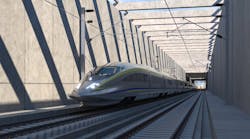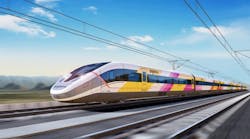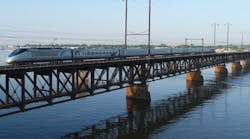FRA awards $8.2 billion in funding for passenger rail projects through two grant programs
The Federal Railroad Administration (FRA) has awarded $8.2 billion in funding for passenger rail projects through the Federal State Partnership for Intercity Passenger Rail (Fed-State National) Program and the Corridor Identification and Development (Corridor ID) Program. The Fed-State National Program funds awarded to rail projects across the U.S. build on $16.4 billion in grants awarded last month through the program’s Northeast Corridor designated funds.
The second set of awards through the Corridor ID Program will support 69 corridors that will develop new high-speed or conventional rail service, extend passenger rail service on existing routes or improve service on existing routes.
“Today, the Biden-Harris Administration takes another historic step to deliver the passenger rail system that Americans have been calling for – with $8.2 billion for faster, more reliable, expanded train service across the country,” said U.S. Transportation Secretary Pete Buttigieg.
In a statement, American Public Transportation Association President and CEO Paul P. Skoutelas said, “The Biden Administration’s announcement today of investments supporting high-performance passenger rail networks are actions that will make our economy stronger, our environment cleaner and economic and social opportunities more equitable. They put America a step closer to the balanced, integrated mobility network needed to compete in the global marketplace. These actions apply resources of the federal Bipartisan Infrastructure Law to support development of ready-to-go corridors while highlighting corridors most ripe for further planning. High-performance rail corridors will relieve congestion on highways and airspace and provide efficient, accessible and environmentally friendly mobility options. President Joe Biden, Secretary Pete Buttigieg, the U.S. Department of Transportation and the Federal Railroad Administration’s forward-looking actions put America on the right track.”
Fed-State National Program
FRA opened funding for the Fed-State National Program in December 2022. At the time, it represented one of the largest funding opportunities for passenger rail in the past 50 years. Projects awarded funds through Fed-State National Program will advance two high-speed rail corridors and fund improvements to existing rail corridors for expanded service and performance. The investments will:
- Help deliver high-speed rail service in California's Central Valley.
- Create a brand-new high-speed rail corridor between Las Vegas, Nev., and southern California, serving an estimated 11 million passengers annually.
- Make major upgrades to existing conventional rail corridors to better connect northern Virginia and the southeast with the NEC.
- Expand and add frequencies to the Pennsylvania Keystone Corridor between Philadelphia and Pittsburgh, Pa.
- Extend the Piedmont Corridor in North Carolina north, as part of a higher-speed connection between Raleigh and Richmond, Va.
- Invest in Chicago Union Station, as an initial step toward future improvements to the critical Midwest corridors hub.
- Improve service in Maine, Montana and Alaska.
“With this funding, we’ll deliver America’s first high-speed rail on a route between southern California and Las Vegas, complete major upgrades for riders in Virginia, North Carolina, Illinois, Pennsylvania, Maine, Montana and Alaska and announce a comprehensive plan that makes it easier to expand passenger rail lines in 44 states,.” said Secretary Buttigieg.
As part of the Fed-State National program, Amtrak has been awarded more than $2.1 billion to improve existing routes and advance plans to expand Amtrak service across the United States. The railroad noted the grants awarded will support existing and future partners, while several grants will support its projects including $108.5 million for Amtrak station and service upgrades and $2 billion for infrastructure upgrades in North Carolina, Virginia, Pennsylvania and Maine.
“Amtrak ridership is soaring and we’re advancing plans to further enhance and expand our services across the United States with our various partners, thanks to these grants,” said Amtrak CEO Stephen Gardner. “We’re eager to bring the benefit of Amtrak’s network and experience to support states and local communities as they work to bring intercity passenger rail to new communities across America.”
The Chicago Hub Improvement Program (CHIP) will benefit from $101 million in funding awarded to Amtrak and its partners in the Midwest. These Fed-State Program grants will help improve the customer experience in Chicago for Amtrak and Metra commuter rail customers – a key CHIP goal — by funding renovation and expansion of the station platforms, improving passenger access and capacity, bringing the platforms into compliance with Americans with Disabilities Act standards, and improving ventilation systems and air quality. This work also includes repurposing platforms designed for mail handling that have been unused since 2005, enabling their use for passengers and supporting long-term rail service expansion across the Midwest.
“At Amtrak, we are working with our partners to maximize Chicago’s role as the central hub of Amtrak’s National Network and position intercity passenger rail as an engine for improved mobility and economic growth,” said Amtrak Board Chair Tony Coscia. “These grant awards propel us on that mission.”
Corridor ID Program
FRA has selected 69 corridors across 44 states through Corridor ID Program, which will drive future passenger rail expansion.
Corridor ID, a new planning program made possible by the Infrastructure Investment and Jobs Act, will help guide intercity passenger rail development throughout the country. The inaugural round of selections aims to upgrade 15 existing rail routes, add or extend service on 47 new routes and advance seven new high-speed rail projects, creating a pipeline of intercity passenger rail projects ready for implementation and future investment.
Examples of planning and development activities selected through the Corridor ID program include:
- New high-speed rail service in the Cascadia High-Speed Rail Corridor between Oregon, Wash., and B.C.
- New high-speed rail service between Dallas and Houston, Texas.
- New and upgraded Midwest Chicago hub corridors as part of the CHIP, including daily, multi-frequency service from Chicago, Ill., to Indianapolis Ind., increased frequencies from Chicago to Milwaukee, Wis., to Minneapolis Minn., with an extension to Madison, Wis., improved service and increased frequencies from Chicago to Detroit Mich., with an extension to Windsor, providing a direct connection to Canada’s high-speed rail network and a comprehensive plan for the Chicago terminal and service chokepoints south of Lake Michigan, benefiting all corridors and long-distance trains south and east of Chicago.
- New service between Minneapolis and Duluth, Minn.
- New service from Fort Collins to Pueblo, Colo., with intermediate stops at Boulder, Denver and Colorado Springs
- New service between Phoenix and Tucson, Ariz., with multiple daily frequencies.
- New service connecting Baton Rouge and New Orleans, La.
- New connections between the NEC and Northern Delaware and Reading and Scranton, Pa.
- Expanded connections and increased frequencies within California’s extensive conventional rail network.
- Expanded connections and service in Florida’s intercity rail network between the key travel markets of Tampa, Jacksonville, Orlando, and Miami, Fla.
- New service between Atlanta and Savanah, Ga., and from Atlanta to Nashville and Memphis, Tenn., via Chattanooga
- Restoration of service between Chicago and Seattle, Wash., through multiple rural communities in North Dakota and Montana that are currently not served by passenger rail
“President Biden’s Bipartisan Infrastructure Law gave us a once-in-a-generation opportunity to think smart and think big about the future of rail in America and we are taking full advantage of the resources we have to advance world-class passenger rail services nationwide,” said FRA Administrator Amit Bose. “Today’s announcement is another step forward as we advance transformative projects that will carry Americans for decades to come and provide them with convenient, climate-friendly alternatives to congested roads and airports. We’re thinking about the future too, with comprehensive and systematic planning efforts to transform the U.S. intercity passenger rail network now and in the years to come.”

Brandon Lewis | Associate Editor
Brandon Lewis is a recent graduate of Kent State University with a bachelor’s degree in journalism. Lewis is a former freelance editorial assistant at Vehicle Service Pros in Endeavor Business Media’s Vehicle Repair Group. Lewis brings his knowledge of web managing, copyediting and SEO practices to Mass Transit Magazine as an associate editor. He is also a co-host of the Infrastructure Technology Podcast.







